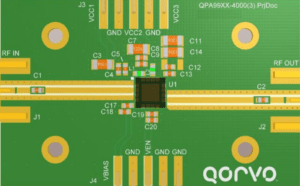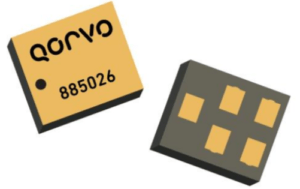Overview
The RF chip is called “the jewel in the crown of the analog chip”, and its importance is self-evident. With the accelerated implementation of 5G, the opening of the new communication era, the number of mobile communication and IoT terminals has increased significantly, and the RF front-end chip, as the core component of the mobile terminal communication system, has ushered in a highlight moment.
According to the statistics of QYR Electronics Research Center, from 2011 to 2018, the global RF front-end market has grown at a compound annual growth rate of 13.10%, reaching USD 14.91 billion in 2018.
By 2023, the market size of RF front-end is expected to exceed 35 billion US dollars, and the compound annual growth rate is expected to reach 16%.
Looking at the global RF front-end chip market is almost monopolized by the three major American RF companies, Qorvo, Skyworks, and Broadcom.

Qorvo’s Advanced Path
Qorvo is a well-deserved giant in the RF field, especially in the RF front-end of mobile phones. Thanks to the accumulation of RFMD and TriQuint in the RF field in the past, Qorvo has inherited the experience of these two companies in the past few years, including base stations, mobile phones and the Internet of Things. Including the wireless market occupies a place.
Qorvo was formed from the merger of RFMD and TriQuint in 2015. RFMD was once the world’s leading designer and manufacturer of high-performance RF components and compound semiconductor technologies that enable global mobility, cellular handsets, wireless infrastructure, wireless local area networks Network (WLAN), CATV/Broadband, and Aerospace and Defense markets to provide enhanced connectivity and support for advanced features.
TriQuint’s product portfolio includes switch and amplifier products, as well as RF filters such as surface acoustic wave (SAW), temperature-compensated surface acoustic wave (TC-SAW) and bulk acoustic wave (BAW) for a variety of wireless and networking infrastructure applications filter.

The combination of the two, combined with their complementary product portfolios, completes Qorvo’s full industrial line layout in antenna control solutions, power amplifier chips, filters and RF switches.
The establishment of Qorvo coincides with the early stage of 5G research and development. Compared with 4G/3G, 5G has the characteristics of high speed, low latency and high frequency, which brings greater challenges to the RF front-end.
First of all, each country and region currently uses different 5G frequency bands. At the same time, due to the high data rate characteristics of 5G, not only mobile phones need to support more frequency bands, but also more antennas, which promotes multi-band carrier aggregation. The introduction of technologies such as MIMO and MIMO has led to new requirements for RF, and Qorvo’s leading BAW and SAW filters, GaAs PAs, SOI antenna tuners and switching solutions can meet the diverse needs of mobile terminals.
Secondly, from the base station side, the 5G network frequency band is mainly divided into two major ranges: Sub-6Ghz and millimeter wave, which is a great improvement compared with the previous network standard. Higher requirements are also placed on radio frequency devices. GaN devices have the characteristics of high power, low power consumption, small size, and can effectively save PCB space. The application of GaN devices to millimeter-wave 5G base stations has become the choice of developers , Qorvo’s leading GaN devices can also meet these needs.
Leading RF devices and technologies have made Qorvo’s performance outstanding in recent years, but Qorvo’s RF strength, not only that, but also the extensive needs of defense, Wi-Fi 6 and the Internet of Things have also contributed to Qorvo’s performance. The acquisitions in recent years have not only broadened Qorvo’s product line, but also enhanced Qorvo’s RF strength.
In 2016, Qorvo announced the acquisition of Green Peak, a leading ultra-low power, short-range RF communications technology company. This acquisition enables Qorvo to expand RF solutions and systems with a broad portfolio of semiconductor products and software technologies for smart home data communications and the Internet of Things, a globally recognized market leader in IEEE 802.15.4 and ZigBee The chip (SoC) provides strong support for its rapid development in the fields of smart home and Internet of Things.
In October 2019, Qorvo acquired Cavendish Kinetics, a supplier of high-performance RF MEMS antenna tuning applications. Qorvo was a major strategic investor in Cavendish Kinetics, which develops RF MEMS devices used to tune smartphone primary and diversity antennas in low, mid, and high frequency bands, resulting in stronger signals and higher data rate. With this acquisition, Qorvo has established a leading position in the field of antenna tuning.
Subsequently, Qorvo completed the acquisition of Custom MMIC. The addition of Custom MMIC, a company in the RF and microwave MMIC space, strengthens Qorvo’s GaAs and GaN RF products for defense and aerospace.
When people are familiar with the role of Qorvo as a provider of radio frequency solutions, in April 2019, Qorvo announced the acquisition of Active-Semi, a provider of smart motor drive solutions, which has attracted widespread attention in the industry. Its goal is the power supply of IoT devices. market.
One of the reasons Active-Semi is attractive to Qorvo is that power management will increasingly contribute to revenue in Qorvo’s focused IDP markets, including 5G base stations, defense active phased arrays, automotive and IoT. Active-Semi can provide customers with power solutions with high integration, high-cost performance, high precision and small size. The combination of Qorvo and Active-Semi can effectively combine power management, PAC and RF, and use power to give RF life, thereby providing the industry with more efficient and higher quality solutions. In addition, the addition of Active-Semi brings new opportunities to the 5G, industrial, data center and automotive markets in addition to IoT.
Another example of breaking new ground through acquisitions is the 2020 acquisition of Decawave, which is primarily focused on developing a low-power chip that provides ultra-wideband (UWB) wireless technology, the company’s pulsed radio UWB technology that enables Centimeter positioning service with extremely low latency. After Apple entered the market, UWB’s attention continued to grow, and mobile devices are an important part of Qorvo’s revenue source. The addition of Decawave has become an effective way for Qorvo to quickly enter the UWB field. In addition, UBW technology is combined with IoT technology, I believe it will have a greater impact.
The battle between RF giants
Mergers and acquisitions in the semiconductor industry are not uncommon. Another giant in the RF industry, Broadcom, was also renamed after Avago acquired the original Broadcom. Now Broadcom’s wireless RF business is one of the original businesses of its predecessor Avago. It mainly produces filtering effects through thin film acoustic resonators (FBARs) to make wireless signals more stable. It is mainly used in iPhone and other smartphone products to strengthen wireless networks. Signal connection efficiency.
Unlike Qorvo, which has been taking a steady and steady course, news of Broadcom’s sale of its radio frequency (RF) division at the end of 2019 has sparked various speculations in the industry. The RF division sold by Broadcom is part of the wireless business, one of the core businesses of which is BAW filters. BAW filters are mainly used in high-end mobile phones, and this business once occupied nearly 90% of the market share, almost in a monopoly position. Nowadays, there are more and more frequency bands in 5G mobile phones, and the frequency is getting higher and higher, and the share of BAW filters is gradually increasing. However, due to its complex manufacturing process and low yield, Broadcom and Qorvo are currently the most mature technologies worldwide. The two accounts for about 95% of the total. However, Qorvo has made a major breakthrough in BAW filters, and its market share has risen sharply. According to data, Qorvo’s BAW filter market share has gradually approached Broadcom in 2019, which may also become the marginalization of the RF chip business in Broadcom. s reason. It is reported that today Broadcom’s focus has begun to shift from semiconductors to more profitable software, and has launched large-scale acquisitions in the software business.

Compared with Qorvo and Broadcom, Skyworks has few acquisitions, and it can be said that it has been fighting alone. Skyworks is a semiconductor company established in 1962 dedicated to the development of radio frequency and mobile communication systems. Skyworks’ main revenue comes from front-end RF modules. In the mobile phone RF front-end market, its power amplifiers and filters account for 33% and 53% respectively. , especially in the field of mobile phone power amplifiers, accounting for more than 40% of the market share, is the only leader in the market. However, there is almost no share in BAW filters. In the future, the RF front-end integration of mobile phones will become higher and higher. Skyworks still needs to make up for the shortcomings of the filter. Broadcom intends to divest the RF business. I wonder if Skyworks will be interested.
Most of Skyworks’ products are sold to Apple, and it is also a radio frequency supplier for many local mobile phone manufacturers. It can be said that it controls the global high-end radio frequency chip market. Unlike Qorvo, Skyworks’ sales growth is largely driven by the efficient operation and organic growth of the company’s product lines rather than mergers and acquisitions. At present, the largest consumer region of its revenue is the United States, and the second largest consumer region is mainland China. The rapid development of China’s mobile phone market in recent years has brought huge business opportunities to Skyworks. In addition, the market once believed that Skyworks will be the main beneficiary of the 5G era, and its 4G/5G SmallCell and Massive-MIMO base station solutions will exert potential in future non-mobile 5G services.
Conclusion
Looking at the global RF chip market, it is almost monopolized by the three major RF chip companies Qorvo, Skyworks, and Broadcom. Now Broadcom intends to divest the RF business, and Skyworks is fighting alone. In contrast, Qorvo has actively deployed the Internet of Things market, and at the same time, 5G construction will also enter the field of intelligent IoT applications. With the blessing of artificial intelligence and 5G, IoT will become the next emerging industry that is generally optimistic about the industry, and this may lead to a reshuffle of the RF market. As for who Will become the head player in the field of radio frequency, and the answer may appear in the near future.
